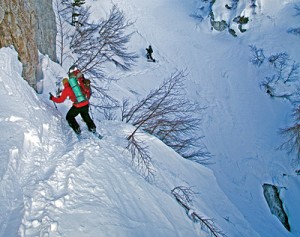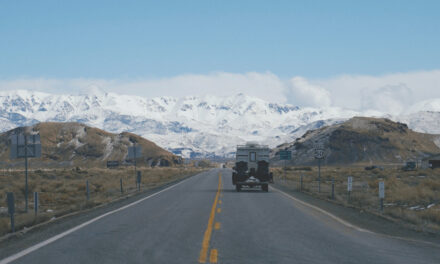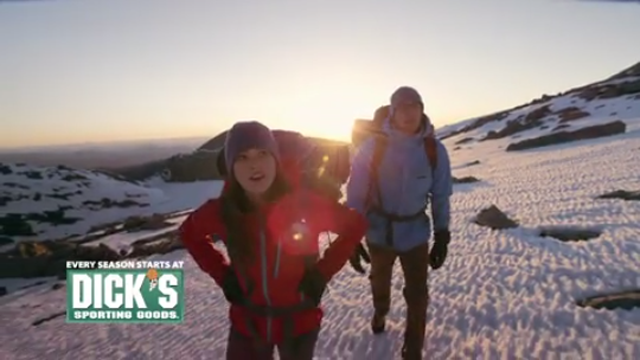- Tahoe’s Nevada Beach Tops the List of Hard-to-Book Campgrounds - 07/17/2024
- Cannabis Watershed Protection Program Cleans Up Illegal Grow Sites - 07/10/2024
- French Fire - 07/05/2024
Thanks to Highway 88 and high elevations, Carson Pass is an easy-access winter playground as soon as the snow flies
Story and photos by Brennan Lagasse
When the first storms make their way over the Sierra each fall, the Carson Pass area is usually one of the first places to find the season’s initial gift of lasting snow within easy reach of a roadside. This has made it a popular early season destination for backcountry skiers and boarders eager to strap on skins and earn their first gravity-harnessing smiles of the year.
Several factors make Carson Pass an ideal winter playground for shaking out the off-season cobwebs.
Adjacent to the south end of the Tahoe Basin, Carson Pass is a reliable early-season storm catcher with its higher elevations. The pass rises to 8,573 feet, more than a thousand feet higher than the other two year-round trans-Sierra passes — Highway 50 over Echo Summit (7,382 feet) and Interstate 80 over Donner Pass (7,239 feet). And the major peaks, such as Round Top on the south side and Red Lake Peak to the north, reach over 10,000 feet.
As they say, there’s no substitute for elevation. Particularly early in the season, the extra grand or so of altitude that Carson offers can make a big difference in ski-ability and safety, not to mention gear preservation.
Along with its loftiness, Carson Pass still sits far enough north (only 15 air miles from South Lake Tahoe) that it rarely gets bypassed by the predominate storm track. Rather, it’s usually smacked right in the teeth by Pacific haymakers that leave behind copious amounts of snow; more than 500 inches most years, as much as 900 inches in profuse ones.
After snow, snow, snow, Carson Pass is ideal ski real estate because it’s got terrain, terrain, terrain. There’s the full gamut, from mellow open bowls to tight tree lines to sphincter-clenching couloirs.
Elephant’s Back
While the tops of the higher peaks in the area may not be good for backcountry skiing early in the season if the snowpack is thin, one of the best places to find reliable early-season skiing is off the slump-shouldered peak known as Elephant’s Back (9,585 feet).
From the Carson Pass Sno-Park (permits are $25/year or $5/day), begin by hiking south from the parking lot just as you would to access most of the other treasures in the area. But as you follow the PCT after a mile or two, peel off to the left heading east.
Note: Since much of this area is in or adjacent to the Mokelumne Wilderness, no snowmobiles are allowed at the two Sno-Parks on the pass, Carson Pass (south side) or Meiss Meadows (north side). Snowmobilers gather at Blue Lakes Road, five miles east.
Elephant’s Back is hard to miss as you come into Hope Valley on Highway 88 or by dropping down Highway 89 over Luther Pass from South Lake Tahoe. But the humpbacked peak has a dramatic and precipitous east face that is hidden from those coming in from the west from the Kirkwood area.
With adequate snow coverage, the east bowl of Elephant’s Back — underneath the dramatic volcanic chutes that make up the back of the “elephant” — offers a collection of runs of a few hundred vertical feet that provide some of the best early powder skiing in the Tahoe region.
Short but sweet, I’ve been lucky to venture there most years and ski several laps with my dogs before finally giving into our collective exhaustion. When the upper chutes fill in you have some classic short, steep, technical terrain that’s only interesting for those wishing to push their limits. These lines don’t get skied often, and when they do skiers and riders are often forced to straightline their descents out into the bowl, or take exit airs at the bottom of the chutes as many of these lines cliff out.
If you know your way around Elephant’s Back, or are lucky enough to link up with a knowledgeable local, you might be able to ski a lap to the base of the east bowl, then do a quick skin or boot back near the base of the Elephant’s Back face, slightly climber’s right. While you’re hiking up look for a flat mound of rock and when you gain that head skier’s left to the top of a few reasonably mellow chutes. The snow in these chutes is often two to three times deeper than in the east bowl.
After choosing your chute of choice, some tight tree skiing leads down to an old forest service road where another quick boot or skin will ultimately lead you back to the top of the pass and your car. Elephant’s Back may not provide the biggest vertical descents in Tahoe, but the hike is short, the snow tends to pile up on the east bowl apron early, and with minimal exposure (watch for falling ice/snow/rocks from the east face) the adventure makes for a great early-season ski tour when other peaks in the Tahoe area may be too thin to descend.
A word of caution: Skiers venturing into the backcountry early in the season need to be especially cautious with the shallow snowpack and the dangers that lie underneath. Making sure you have a good idea of what you are skiing over is mandatory to ensure your trip is fun and safe, and doesn’t result in an injury that might pre-empt the rest of your season, or worse.
Round Top
When Carson Pass gets hammered with a few feet of good base material — a.k.a. Sierra cement, an often derided and underappreciated foundation courtesy of our Pacific proximity—with perhaps a light finishing layer of fluff on top, that’s when you can really venture out and get some unique backcountry skiing ranging from the steep-walled confines of Round Top (elevation 10,381) to the mellow ramps and bowls of the Sisters. These are also excellent tours to do in the spring when the snowpack is in a corn cycle, and also make great destinations for easy-access snow camping.
Round Top is the crown jewel of Carson Pass — partly because it’s the tallest of the bunch, partly because it stares right at every passerby as they drive over the pass, but mostly because the Moon Crescent Couloir, which splits right down the middle of the peak, is arguably one of the most aesthetic ski lines in the greater Tahoe area.
At first glance the couloir seems impossibly steep and extremely narrow. But if your skills are sharp in tight, vertical terrain then this is definitely a line you want to add to your tick list.
It’s not for the faint of heart. While you can tour up the west side of Round Top to gain the entrance to the couloir and lessen your overall exposure, you’ll miss the beta collection that only comes when you climb what you ski. The boot pack up the couloir isn’t too bad with crampons and an ice axe, but the tricky traverse near the top always gets me a little puckered. Once you negotiate the traverse and gain the relative safety of the walled couloir, the steepness relents from around 50 degrees to the mid-low forties.
The Sisters
If you’re looking for something a little less intense, but still want some great skiing, bypass Round Top to the west or ski its shoulder on your way out to the Sisters. Sister 1 and 2, as they’re generally referred to, offer diverse descents that range from mellow milking turns to the increasingly steep fall lines off the summits.
Red Lake Peak
Another fantastic option on Carson Pass is to head north to the great backcountry skiing off Red Lake Peak. There are many ways to access the terrain on Red Lake Peak depending on what section of the mountain you intend to ski. All aspects offer great skiing at different times of the year.
Access can be as easy as hiking right from Highway 88, but many backcountry users choose to shuttle a car leaving one vehicle at the Meiss Meadow Sno-Park and one at the bottom of Crater Lake Road (a few miles east on Highway 88). You can also choose to skin up Crater Lake Road to the base of the peak, or drive it when it’s clear (high-clearance 4WD recommended) and you’ll eventually arrive at a beautiful confluence between Red Lake Peak and neighboring Steven’s Peak. Bountiful terrain encircles everywhere you look.
All in all, whether you’re looking to snowshoe the PCT, head out for a low-angle cross-country ski, hunt for powder stashes or test your steep skiing skills in the Moon Crescent Couloir, Carson Pass has a little bit of something for every calorie-powered winter enthusiast.
Brennan Lagasse is a writer and environmental consultant living in South Lake Tahoe.















